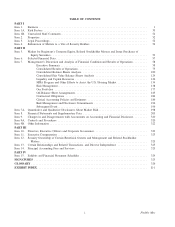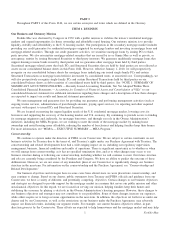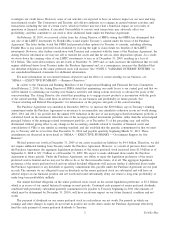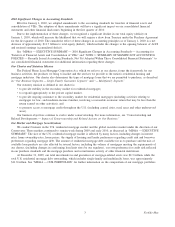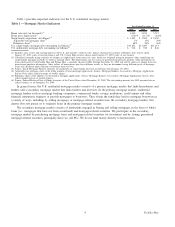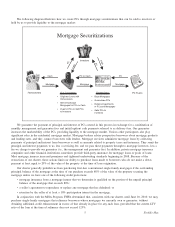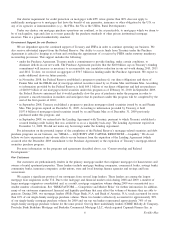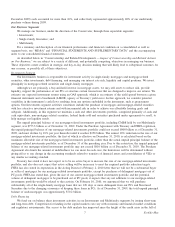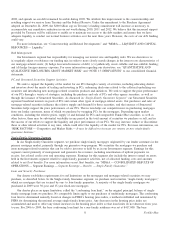Freddie Mac 2009 Annual Report Download - page 5
Download and view the complete annual report
Please find page 5 of the 2009 Freddie Mac annual report below. You can navigate through the pages in the report by either clicking on the pages listed below, or by using the keyword search tool below to find specific information within the annual report.to mitigate our credit losses. However, some of our activities are expected to have an adverse impact on our near and long-
term financial results. The Conservator and Treasury also did not authorize us to engage in certain business activities and
transactions, including the sale of certain assets, which we believe may have had a beneficial impact on our results of
operations or financial condition, if executed. Our inability to execute such transactions may adversely affect our
profitability, and thus contribute to our need to draw additional funds under the Purchase Agreement.
On February 18, 2010, we received a letter from the Acting Director of FHFA stating that FHFA has determined that
any sale of the LIHTC investments by Freddie Mac would require Treasury’s consent under the terms of the Purchase
Agreement. The letter further stated that FHFA had presented other options for Treasury to consider, including allowing
Freddie Mac to pay senior preferred stock dividends by waiving the right to claim future tax benefits of the LIHTC
investments. However, after further consultation with Treasury and consistent with the terms of the Purchase Agreement, the
Acting Director informed us we may not sell or transfer the assets and that he sees no other disposition options. As a result,
we wrote down the carrying value of our LIHTC investments to zero as of December 31, 2009, resulting in a loss of
$3.4 billion. This write-down reduces our net worth at December 31, 2009 and, as such, increases the likelihood that we will
require additional draws from Treasury under the Purchase Agreement and, as a consequence, increases the likelihood that
our dividend obligation on the senior preferred stock will increase. See “NOTE 5: VARIABLE INTEREST ENTITIES” to
our consolidated financial statements for additional information.
For more information on our current business objectives and the effect of conservatorship on our business, see
“MD&A — EXECUTIVE SUMMARY — Business Objectives.”
In a letter to the Chairmen and Ranking Members of the Congressional Banking and Financial Services Committees
dated February 2, 2010, the Acting Director of FHFA stated that minimizing our credit losses is our central goal and that we
will be limited to continuing our existing core business activities and taking actions necessary to advance the goals of the
conservatorship. The Acting Director also stated that permitting us to engage in new products is inconsistent with the goals
of the conservatorship. This could have an adverse effect on our business and profitability in future periods. See
“Conservatorship and Related Developments” for information on the purpose and goals of the conservatorship.
The Purchase Agreement was amended in December 2009 to: (i) increase the $200 billion cap on Treasury’s funding
commitment under the Purchase Agreement as necessary to accommodate any cumulative reduction in our net worth during
2010, 2011 and 2012; (ii) provide that the annual 10% reduction in the size of our mortgage-related investments portfolio is
calculated based on the maximum allowable size of the mortgage-related investments portfolio, rather than the actual unpaid
principal balance of the mortgage-related investments portfolio, as of December 31 of the preceding year, and will be
determined without giving effect to any change in the accounting standards related to transfers of financial assets and
consolidation of VIEs or any similar accounting standard; and (iii) establish that the periodic commitment fee that we must
pay to Treasury will be set no later than December 31, 2010 and payable quarterly beginning March 31, 2011. These
amendments are discussed in more detail in “MD&A — EXECUTIVE SUMMARY — Government Support for Our
Business.”
We had positive net worth at December 31, 2009 as our assets exceeded our liabilities by $4.4 billion. Therefore, we did
not require additional funding from Treasury under the Purchase Agreement. However, as a result of previous draws under
the Purchase Agreement, the aggregate liquidation preference of the senior preferred stock increased from $1.0 billion as of
September 8, 2008 to $51.7 billion as of December 31, 2009. We expect to make additional draws under the Purchase
Agreement in future periods. Under the Purchase Agreement, our ability to repay the liquidation preference of the senior
preferred stock is limited and we may not be able to do so for the foreseeable future, if at all. The aggregate liquidation
preference of the senior preferred stock and our related dividend obligations will increase further if additional draws under
the Purchase Agreement or any dividends or quarterly commitment fees payable under the Purchase Agreement are not paid
in cash. The amounts we are obligated to pay in dividends on the senior preferred stock are substantial and will have an
adverse impact on our financial position and net worth and could substantially delay our return to long-term profitability or
make long-term profitability unlikely.
Our annual dividend obligation on the senior preferred stock, based on the current liquidation preference, is $5.2 billion,
which is in excess of our annual historical earnings in most periods. Continued cash payment of senior preferred dividends,
combined with potentially substantial quarterly commitment fees payable to Treasury beginning in 2011 (the amounts of
which must be determined by December 31, 2010), will have an adverse impact on our future financial condition and net
worth.
The payment of dividends on our senior preferred stock in cash reduces our net worth. For periods in which our
earnings and other changes in equity do not result in positive net worth, draws under the Purchase Agreement effectively
fund the cash payment of senior preferred dividends to Treasury.
2Freddie Mac


